
Email Blast Software Module
UNDER REVIEW
Aegis Premier Solutions is pleased to announce the release of our Email Blast Software Module as part of our Aegis CRM Fundraising software solution. This addition, tied to the Aegis CRM CMS Module, allows any of our clients to send an Email Blast, track "click-through" and capture donations directly into the Aegis CRM Database by using our "Donate Now" CMS page.
Please contact Aegis CRM Customer Support for pricing on sending out email messages, acquiring email addresses for your existing Partners and to schedule training on setting up and sending out your first Email Blast using this vital fundraising channel.
Terms you should know:
- CMS stands for "Content Management System." A Content Management System is a Web application designed to make it easy for non-technical users to add, edit and manage a Website.
Create an Email Blast Appeal
Create a new Appeal as a solicitation
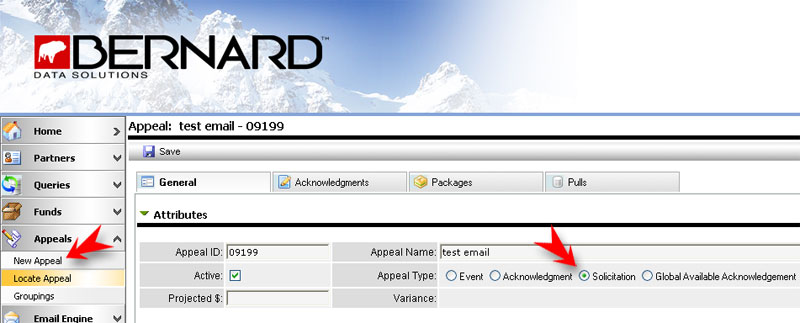
After establishing the Appeal and the Appeal name, select the ”Packages” tab to define the packages to be offered and to design the HTML page (or pages) to be sent to the Partners.
Enter the Package ID and Description, then click "Select" next to "Email Template."

Create an Email Template
Clicking "Select" will display an "Email Templates" dialog box from which you can choose to create a "New Email Template" or select a previously created template from a list.

If creating a new Email Template, the "Add Email Template" dialog box will be displayed. Enter a descriptive Template Name, such as ”Email_newsletter_nov2009.” On the "Subject" line, enter the subject text that will be seen by the Partner in the email message. There is a box to the immediate right of the subject line (as shown below) that enables the merging of database fields into the subject line. This can be used to insert the Partner's name or other personal information into the subject line text.
Enter the body of the email message including any design or graphics elements that are to be part of the message. Use the box on the toolbar ("Insert Merge Field, shown below) to open a pop-up box which provides the available Aegis CRM database fields for use as merge fields in the body of the message.

Position your cursor at the point in which you want a database field to be inserted, then click the "Insert Merge Field" box. The merge insertion dialog box will be displayed from which you can select the field you wish to have inserted into the email text.
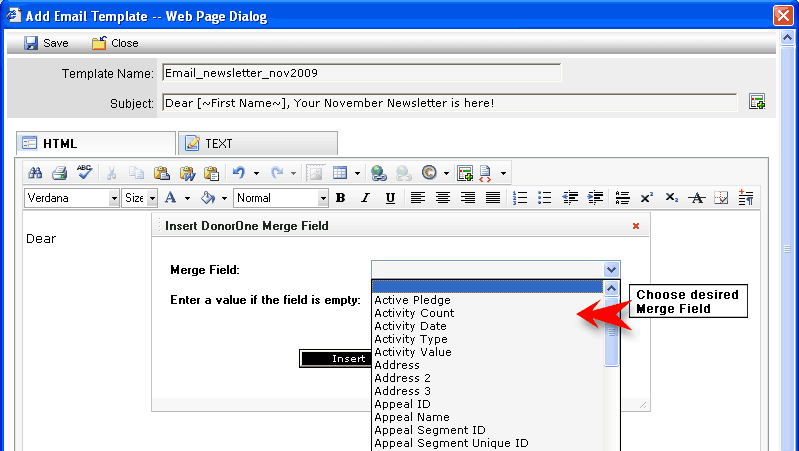
It is typically good practice to enter an alternate value for the selected database field in case there is no value in the field. In the example shown below, the text is intended to read, "Dear (First Name). However; if the (First Name) field is empty, the text will read, "Dear Friend." Click "Insert" when you have completed the merge field selection.
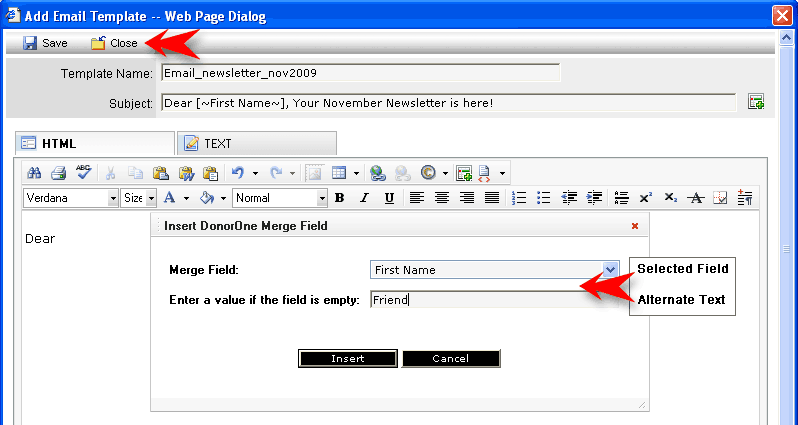
When you have finished entering the body of the email message, including pictures or other design elements, click ”Save” and "Close" to save the new template.
The new template, including all of the text and merged information, will be displayed. Use the "X" in the upper right corner to close the displayed template.
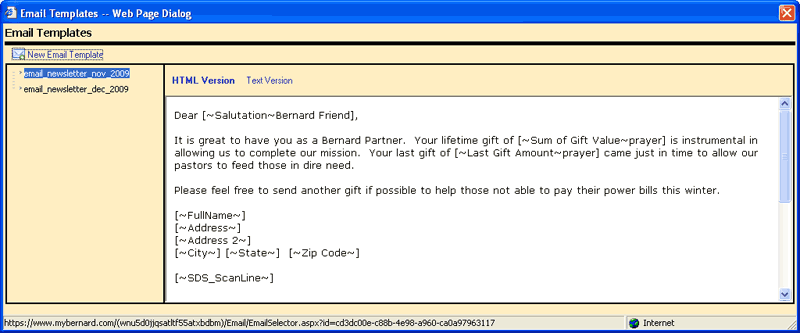
Edit, Preview or Delete an Email Template
Back on the Packages Tab, next to "Email Template" are additional options for working with the Email Template.
- Edit will open the Template and allow you to make and save changes.
- Send Preview will enable you to have your email document sent to your email box. This will enable you to view the message exactly as your Partners would view it.
- Delete will enable you to remove the Template from the Appeal.

Create an Email Pull
Under the ”Pulls” tab, select ”Create New Pull.” The "Create New Pull" dialog box will be displayed. (See Appeal Pulls for more information on Pulls).
- Set the Channel to ”Email”
- Check the ”Send Now” box if you plan to send the email right away.
- Choose to "Create a Blank Pull" or to "Use a prior pull for a template"
- Click "Save" to display the "Pulls" work screen
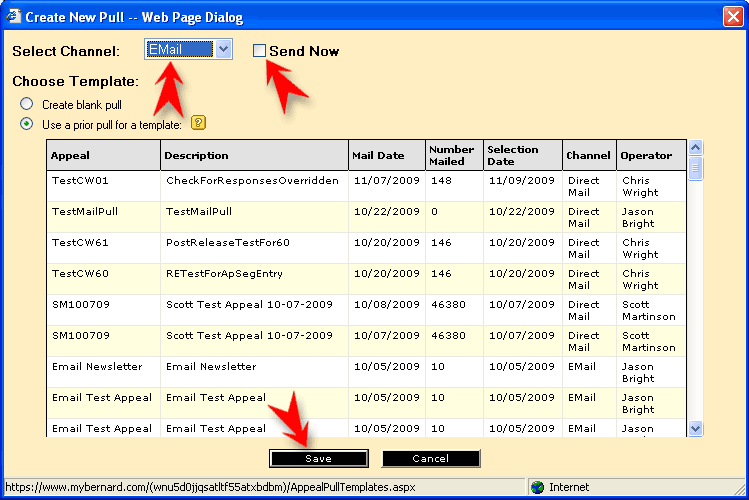
The "Pulls" work screen is where you will set the guidelines governing which Partners are pulled for this Email Blast.
Two Appeal-Segments are automatically added to the Email Pull for the purpose of omission:
- Those Partners with the ”No Email Solicitation” flag turned on;
- Those Partners who have no email address recorded in the ”Primary Email address” field of their record.
Under "Global Attributes:"
- Enter the Email Date and Email Time
- The Channel of ”Email” should already be selected (if not, then be sure to set it here)
- Set the Pull criteria to select those Partners who will receive the Email Blast
- Add Email Appeal-Segments (such as Appeal-Segment 100, below) as may be needed based on the organization’s business rules
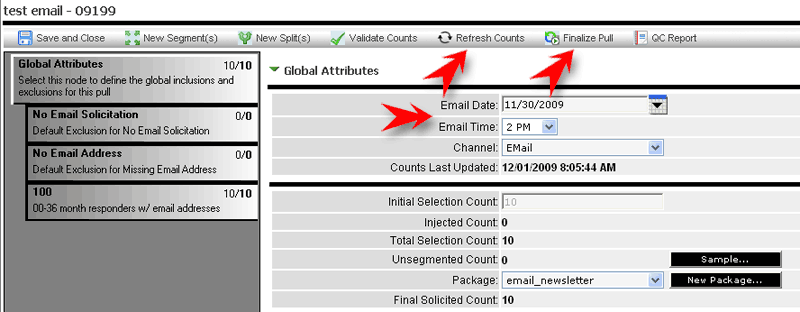
Once you have set the Pull to select all of the Partners who should receive the Email Blast, click on ”Refresh Counts” to verify the number of emails to be sent. Upon verification of the counts, click on ”Finalize Pull.” This will execute the Email Blast based on the date and time entered in the ”Global Attribute" record of the Pull.
View Statistics
Under the "Email Engine" tab, choose "View All Email Jobs." Click the "Upcoming Email Jobs" tab or the "Past Email Jobs" tab, and use the Search Criteria fields to locate the Email Blast you wish to view. Next to the email job you wish to view, click on the arrow under "Available Actions" and choose "View Email Statistics."
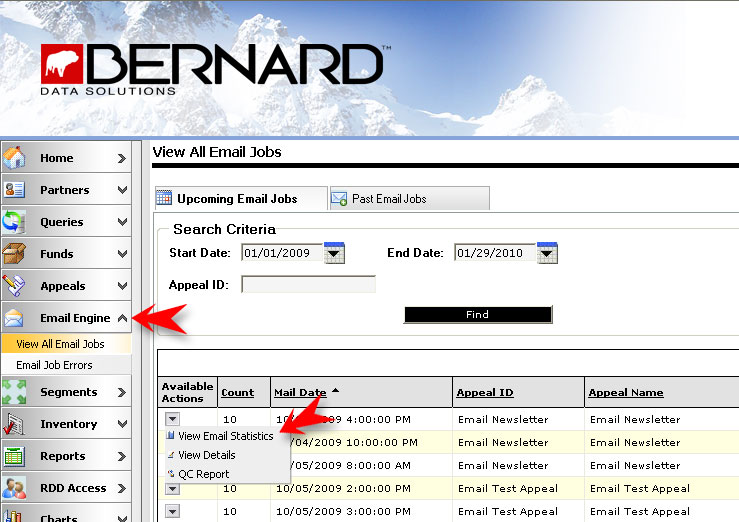
This dialog box will be displayed, showing the current statistical information about the Email Blast. Reporting statistics will be updated on a daily basis for all email blasts less than 14 days old.
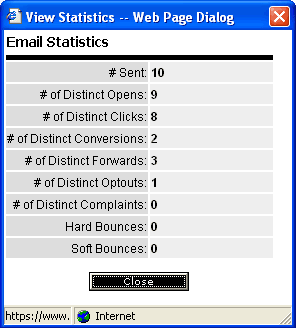
Statistics Definitions
- # Sent: The total number of email messages sent to Partners in this Email Blast.
- # of Distinct Opens: The total number of email messages that were opened by the Partners.
- # of Distinct Clicks: The number of times a recipient clicked on any HTML link that was contained within the email message.
- # of Distinct Conversions: A conversion occurs if a recipient clicks on a link in the email and performs a certain action (for example: The recipient clicks a "Donate" link in the email and makes a donation). Conversions can be tracked on donations made through the Aegis CRM donation page as well as on donations made through an HTML snippet placed on a particular page within your own Website. For more information about using a "Donate" link, please contact Aegis CRM Customer Support.
- # of Distinct Forwards: The number of times a recipient forwarded the email.
- # of Distinct Optouts: The total number of Partners who asked to not receive further email messages from your organization. When a Partner selects to Opt Out, the "Do Not Email" flag will automatically be set on in Aegis CRM.
- # of Distinct Complaints: The number of times a recipient lodged a complaint about receiving an email.
- Hard Bounces: The number of times the receiving server for an email address reported a hard bounce to Aegis CRM. (A "hard bounce" occurs when a receiving server sends a "return to sender" email message due to an invalid - typically inactive or unknown - email address). If a hard bounce occurs, Aegis CRM will no longer attempt to send emails to that address.
- Soft Bounces: The number of times the receiving server for an email address reported a soft bounce to Aegis CRM. (A "soft bounce" is an e-mail message that gets as far as the recipient's mail server but is bounced back undelivered before it gets to the intended recipient). This is usually due to the subscriber having a full Inbox or a temporary server problem on the receiving side. If a soft bounce occurs, Aegis CRM will attempt to email that address again in the future. However, if a soft bounce occurs more than 3 times for a given email address, Aegis CRM will consider that email address undeliverable, and will no longer attempt to send emails to that address.